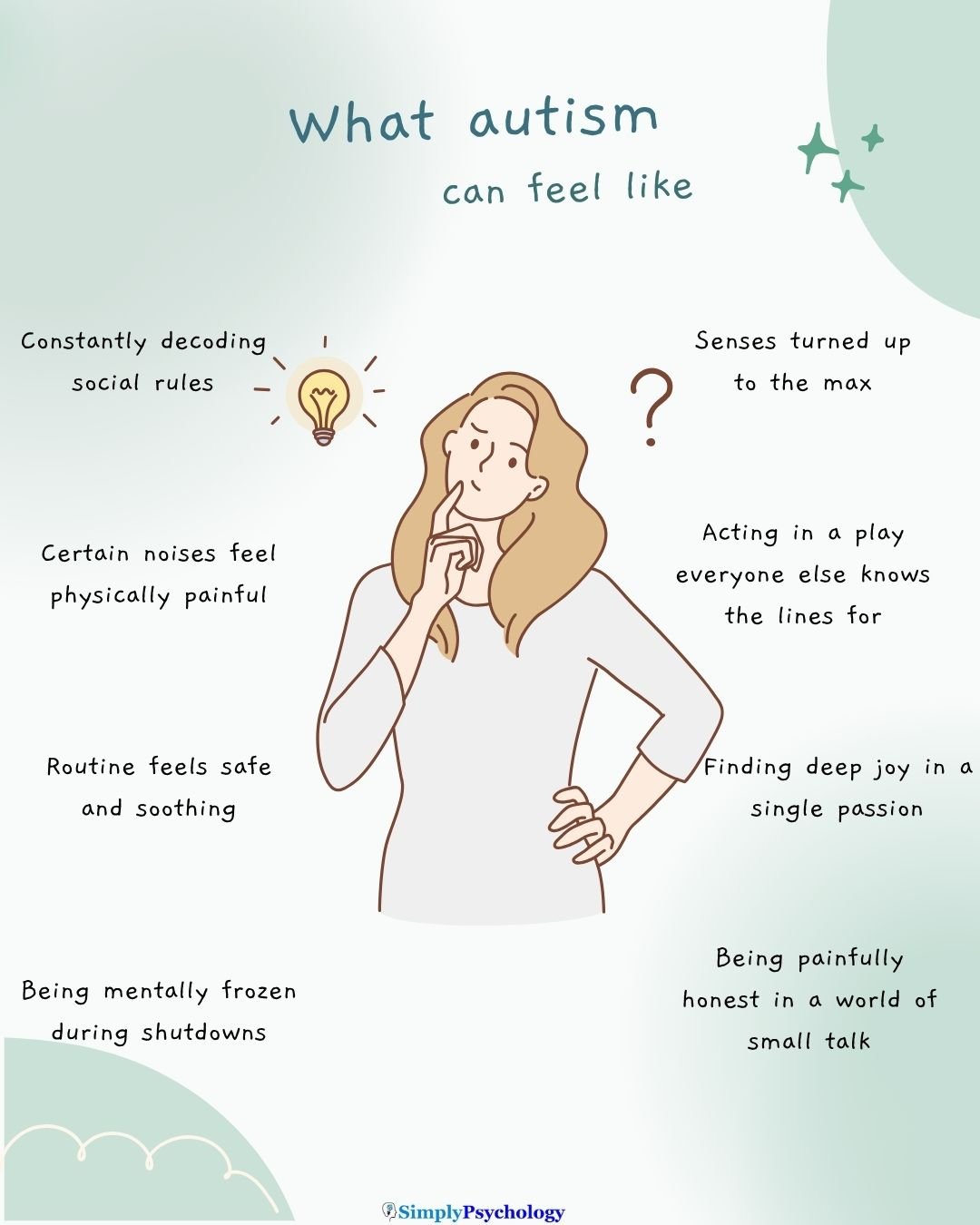Autism isn’t a single experience—it’s a spectrum that shapes how a person feels, thinks, senses, and connects. But what does it actually feel like to be autistic?
For many, it means navigating a world that often feels too loud, too fast, and deeply confusing—while also experiencing profound joy, focus, and emotional sensitivity.

This article draws from firsthand accounts to illuminate the rich, nuanced, and often misunderstood inner world of autistic people.
1. The World Feels Too Much—Or Not Enough
Overwhelming Sensations
Many autistic individuals experience sensory hypersensitivity, where everyday sights, sounds, or textures feel unbearably intense. One person described it as:
“Everything, all at once, all the time.”
Loud sounds can feel like physical pain:
“Noise and sound feel like they are constantly assaulting me.”
“The sound of cutlery on crockery is painful.”
Bright lights might trigger migraines or emotional dysregulation:
“I wear sunglasses everywhere… interior lights make my brain hurt.”
Touch can be distressing—even soft fabrics can cause discomfort:
“Clothes feel disgusting.”
“A flannel feels like being electric shocked.”
This constant sensory input can lead to overload, making daily tasks exhausting and sometimes resulting in meltdowns or shutdowns, where a person may freeze or mentally “check out.”
Calming and Positive Sensations
On the other hand, some autistic people are hyposensitive—they seek sensory input that calms or regulates them.
“Lying on the ground is the most sensory releasing experience.”
Soft textures, familiar music, stimming (e.g., rocking, hand flapping), or weighted blankets can feel incredibly soothing.
“I suck my thumb… it’s a stim. It’s what I do. I like it. Just feels nice.”
2. Socializing Feels Like Performing in a Foreign Language
Masking: The Social Survival Strategy
Social interactions often require masking—the conscious or unconscious effort to act neurotypical by mimicking eye contact, gestures, or small talk.
“It’s like solving math equations in your head all day.”
People develop social “scripts” and closely monitor their behavior. The goal is to fit in, but the cost is high: fatigue, anxiety, and a loss of identity.
The Emotional Cost of Connection
Even when autistic people want connection, it can feel fraught with self-doubt:
“I have an almost constant sense of feeling like I’m doing everything wrong.”
There’s often a heightened sensitivity to rejection—a friend’s silence can spiral into panic. This contributes to chronic anxiety, overanalysis of social situations, and loneliness, even when social desire is present.
The Double Empathy Problem
Many difficulties arise not from a lack of empathy, but from differences in communication styles.
The “double empathy problem” suggests that misunderstandings between autistic and non-autistic people go both ways—not just a deficit in autistic individuals.
3. Deep Interests Bring Joy, Purpose, and Peace
Special Interests: A Source of Autistic Joy
Many autistic people experience intense passions—not just hobbies, but consuming interests that bring meaning and structure.
“I lose myself in it—it feels amazing.”
These “special interests” offer focus, direction, and emotional regulation. They’re often rich, creative, and intellectual outlets.
Routine, Stimming, and Regulation
Repetition and predictability feel grounding. Activities like stimming, engaging with special interests, or following daily routines help regulate emotions and sensory input.
Strengths and Sensitivities
Autistic individuals often show exceptional honesty, loyalty, and a strong sense of justice. The idea that autistic people lack empathy is a myth—many are hyper-empathic, feeling others’ pain deeply.
“I absorb emotions from others—it can be overwhelming.”
Some thrive in solitude, while others cherish deep, authentic connections.
“Friends are exhausting and pointless honestly, but I still value real connection.”
4. The Hidden Struggles Others Don’t See
Executive Dysfunction
Autistic people often struggle with executive functioning, making tasks like planning, transitioning, or organizing feel overwhelming.
“I spend hours inside my head planning basic tasks.”
“Making a meal or cleaning is just… too much.”
These difficulties are often misunderstood as laziness or irresponsibility.
Shutdowns and Internal Collapse
When overwhelmed, autistic people may shut down—a form of burnout or dissociation.
“It’s like being frozen or disconnected from my body.”
Outwardly, they might appear calm, but inside they’re in crisis.
“They’ll go home and shut down for the rest of the night—but no one will see it.”
The Long-Term Toll of Masking
Years of masking can lead to autistic burnout, especially in undiagnosed or late-diagnosed adults.
“The strain and drain of it suddenly becomes too much and a person falls apart.”
Burnout is more than fatigue—it includes chronic exhaustion, loss of skills, and increased sensory sensitivity.
5. Realizing You’re Autistic Can Be Transformative
Many autistic adults are diagnosed later in life, after years of feeling “different” but not understanding why. This realization can bring profound relief—alongside grief.
“I thought I was broken. Now I know I’m wired differently.”
Diagnosis helps reframe a life story, validating struggles and strengths. It opens the door to self-acceptance and community—though it may also bring sadness about missed support or misunderstood years.
Conclusion: A Different Way of Being
To be autistic is not to be broken or defective—it’s to experience the world differently, sometimes painfully, sometimes beautifully.
While social norms and sensory environments may pose challenges, autistic people also live with extraordinary focus, depth, and sensitivity.
Understanding what it feels like to be autistic means listening to those who live it—and recognizing the humanity behind the diagnosis.

